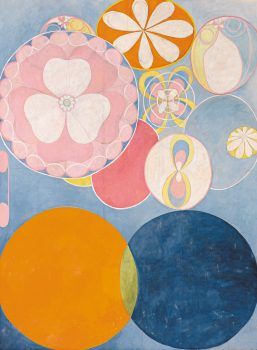Susan Tallman at the NYRB:

Born in 1862 to a prominent Swedish family (her great-grandfather had been ennobled for services as a naval officer), Hilma af Klint was a skilled painter of portraits and landscapes who in the first decades of the twentieth century began making hundreds of strange pictures articulating the fluid relations between spirit and matter. Many have no basis in the visible world, and their early dates—in some cases years before such benchmark abstract paintings as Wassily Kandinsky’s Composition VII (1913) or Kazimir Malevich’s Black Square (1915)—have led to excited claims for af Klint as the unknown woman who pipped all the famous men to the post. This is the seductive pitch behind the Guggenheim’s much-lauded exhibition “Hilma af Klint: Paintings for the Future,” the first comprehensive American overview of the artist now hailed, some seven decades after her death, as the female progenitor of modernist abstraction. Even if this were true—and it really isn’t—it would be the least material or interesting thing about this ecstatic and perplexing body of work.
Af Klint was one of many artists (including Kandinsky and Malevich) drawn to the esoteric philosophies that flourished in the late nineteenth and early twentieth centuries—Spiritualism, Theosophy, Anthroposophy, and the like. But af Klint’s engagement went deeper than most, and she was tenacious in her pursuit of personal spiritual contact.
more here.
